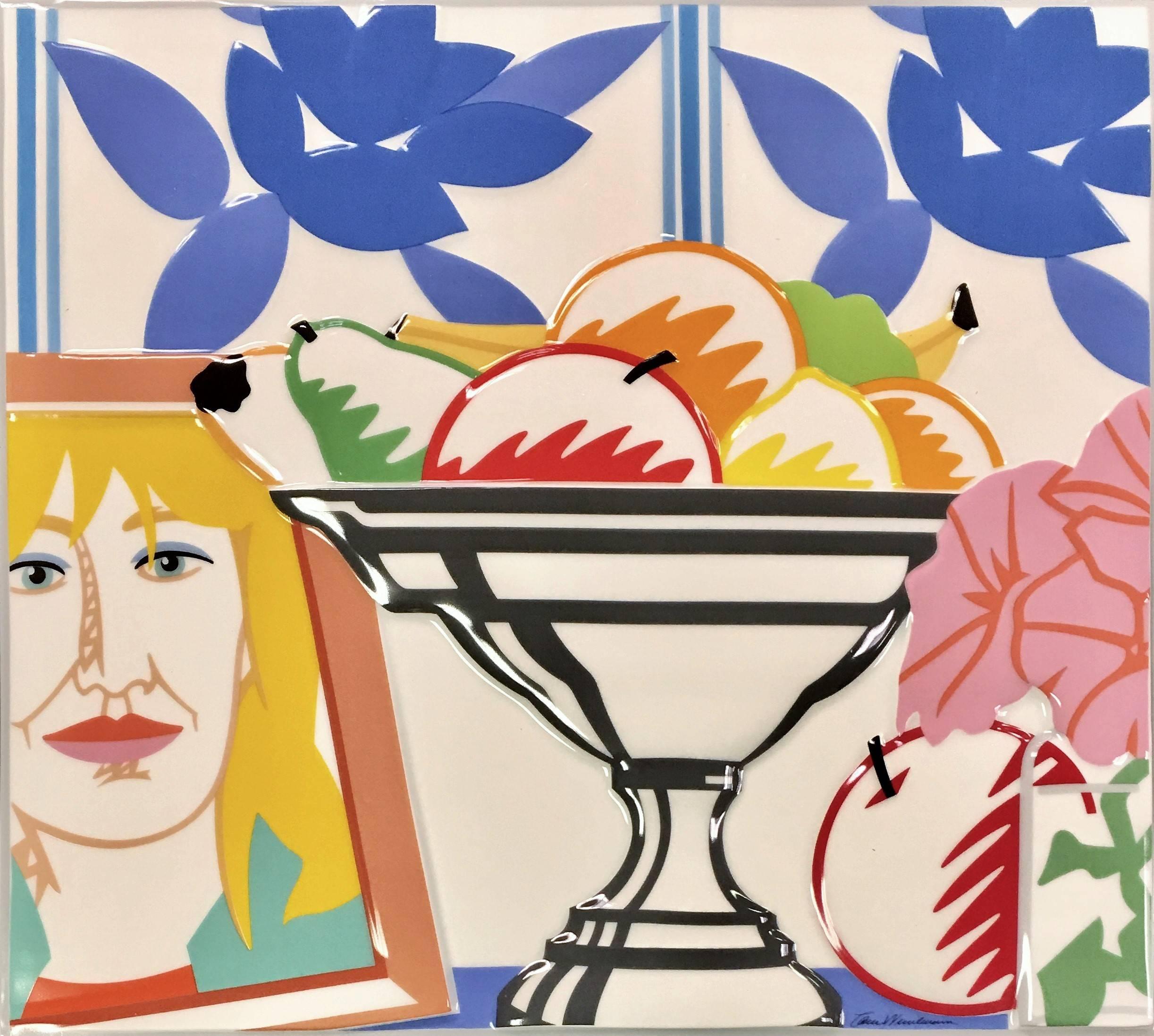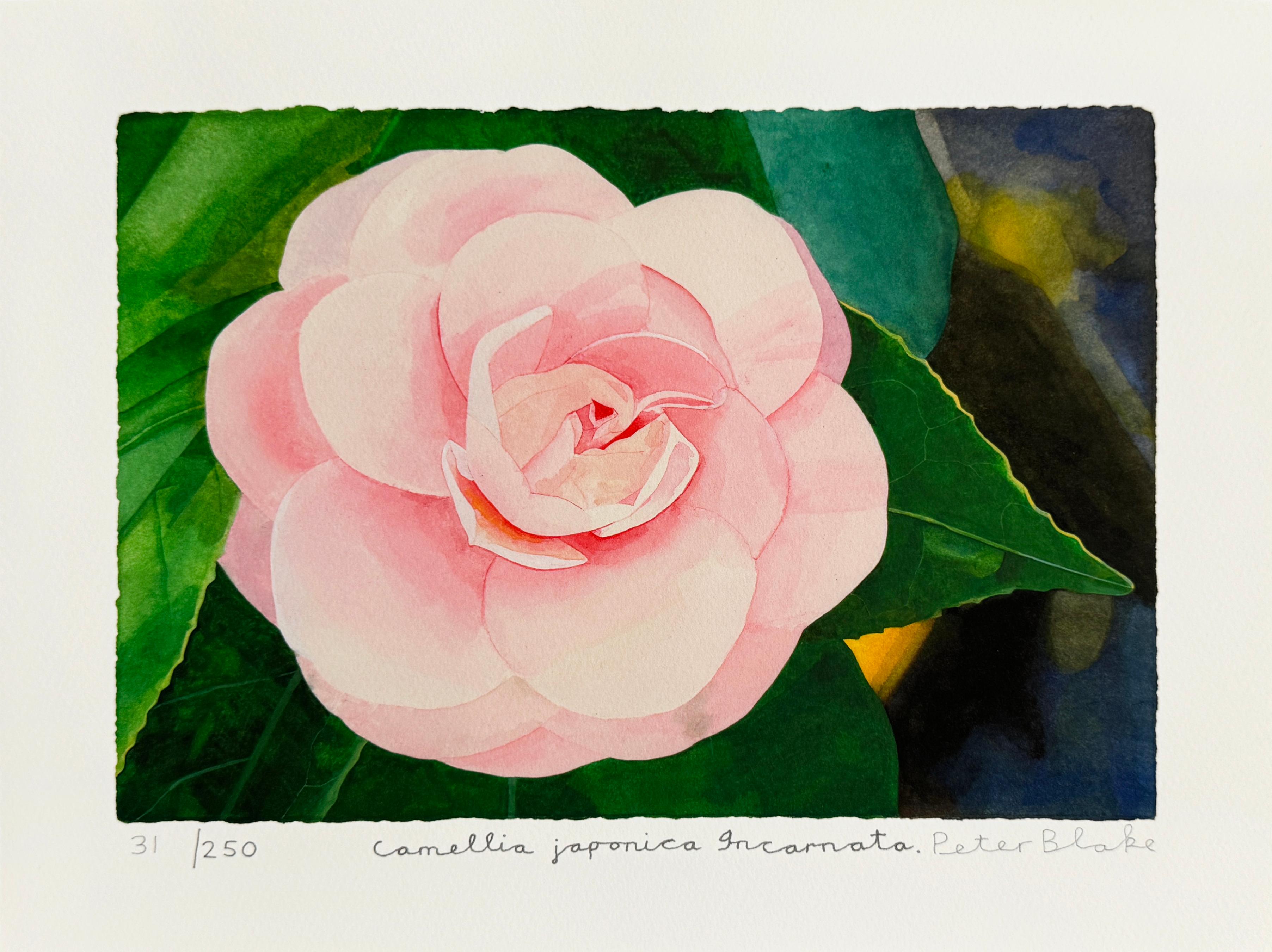Items Similar to Still Life on Porcelain
Want more images or videos?
Request additional images or videos from the seller
1 of 7
Tom WesselmannStill Life on Porcelain1988
1988
About the Item
Tom Wesselmann, (1931-2004)
"Still Life" (Stilleben) 1988
Porcelain with Polychrome
Ed. 169/299
Porcelain Size: approx. 13 x 14 inches
Overall Size: approx. 18 3/4 x 20 inches
Found./Pub. Rosenthal
Known for his Pop-Art nude figures--the Great American Nude Series--as well as collages, often with food themes, Tom Wesselmann is a Cincinnati born artist who studied at the Art Academy of Cincinnati and at Cooper Union* in New York City in the late 1950s.
When he was a student at Cooper Union, he was much influenced by Abstract Expressionism*, especially painters Willem de Kooning and Jackson Pollock. However, he turned away from that style because he determined these artists had become so introspective that there was little room for creative exploration by others.
His reaction took him to Pop Art, the other extreme of action painting to a tightly controlled style and subject matter that was mundane--the antithesis of psychological complexities. Joining a rebellion against the New York School of Abstract Expressionists that which had become the establishment, he, like Andy Warhol and Wayne Thiebaud, asserted that everyday objects had significance unto themselves and that they were worthy of depiction because of a common understanding about what they were.
Of this reaction, Norman Geske, Director of Sheldon Memorial Art Gallery, wrote, "The swing of the pendulum was complete, from the esoteric to the commonplace, from passionate individualism to the popular language of the marketplace. The new point of view was not merely popular, it was 'pop,' assertive, declamatory, defiant, achieving a stylistic identity in the soup cans of Andy Warhol, the comic strips of Roy Lichtenstein, the billboards of James Rosenquist, and the domestic icons of Tom Wesselmann."
In 1959, Wesselmann began his collages, which show influence of modernist artists ranging from Willem de Kooning to Henri Matisse. These collages were usually interior scenes with nude figures, a subject he did so repeatedly that it seemed an obsession. During the mid-1960s, he focused solely on female nudes, presenting them as sex objects with emphasis on breasts, mouth, and genitalia.
- Creator:Tom Wesselmann (1931 - 2004, American)
- Creation Year:1988
- Dimensions:Height: 18.75 in (47.63 cm)Width: 20 in (50.8 cm)Depth: 1 in (2.54 cm)
- Medium:
- Movement & Style:
- Period:
- Condition:
- Gallery Location:Missouri, MO
- Reference Number:1stDibs: LU74735527772
About the Seller
5.0
Vetted Seller
These experienced sellers undergo a comprehensive evaluation by our team of in-house experts.
Established in 1970
1stDibs seller since 2017
141 sales on 1stDibs
Typical response time: 22 hours
- ShippingRetrieving quote...Ships From: Missouri, MO
- Return PolicyA return for this item may be initiated within 2 days of delivery.
More From This SellerView All
- Apple (Poster) -- signedBy Roy LichtensteinLocated in Missouri, MOHand-Signed and dated Lower Right Original screenprint poster in yellow, red, blue an black on white wove paper. Designed by the artist for a traveling exhibition for the Saint Lou...Category
1980s Pop Art Still-life Prints
MaterialsScreen
- Brown CottonwoodLocated in Missouri, MOBrown Cottonwood, 2005 By Andrew Millner (American, b. 1967) Lightjet Print Mounted on UV Plex Signed Lower Right Unframed: 87" x 44" Framed: 88" x 45" Andrew Millner is a visual artist based in St. Louis, MO. His work investigates the relationship between art and nature, the natural and the made. Millner received a BFA from University of Michigan, in Painting and Sculpture. He has had more than 56 group exhibitions since 1987 and over 15 solo exhibitions at institutions including Miller Yezerski Gallery, Boston, Massachusetts; Ellen Miller Gallery, Boston, Massachusetts; CCA, Santa Fe, New Mexico; Tria Gallery, New York City, New York; Richard Levy Gallery, Albuquerque, New Mexico; David Floria Gallery, Aspen, Colorado; Contemporary Museum St. Louis, St. Louis, Missouri. "I started drawing on the computer in 2005. Previous to that, most of my work had been about finding lines in nature; the contours of leaves, the ripples on rivers, the edges of overlapping hills. Although I was using traditional art materials, I prepared the canvases with slicker and slicker surfaces so that the lines wouldn’t soak into the background but sit on top, preserving the nuances of my hand. I thought of the drawings as photographic, in the diaristic sense of recording moments of time. I enjoyed the easy correspondence of the endless novelty of line in these natural forms and the endless variety of line created by my hand. I couldn’t draw the same leaf twice so my subject and process were well matched. I had the idea to draw every leaf of a tree, but I struggled with the scale and complexity of the subject. How does one bring a tree indoors? How can one see the whole tree and its individual parts simultaneously? I tried traditional strategies and materials but the results were unsatisfactory. I wondered if it would be possible to make the drawing on a computer. Since everything… music, photos, movies & books were being digitized, what about drawing? I wasn’t interested in something computer-generated, but sought to “dumb down” the computer and use it as a repository for simple line drawings. In the program I use, Adobe Illustrator, lines are called “paths”… an apt name since the line exists at no set scale or color. Only later do I assign the attributes of color and thickness. Taking my laptop outdoors, I drew my first tree “en plein air.” Using a digital tablet and pen, I drew simple contours of the leaves and branches. Having these drawings remain in digital form rather than in physical form, opened up interesting possibilities and enabled me to tackle the complexity of a tree in intriguing ways. My lines were free and separate from the background and from each other. I drew the branches individually and then later, I could cobble them together to reconstitute the whole tree. On the screen, I could zoom in and out and draw at different scales simultaneously. I could zoom out to draw a simple contour of the entire trunk and then zoom in to draw the smallest leaf with equal effort. I drew in layers so that as the drawings accumulated I could turn layers “off” so that they wouldn’t obscure subsequent layers. These two novelties, drawing at different scales simultaneously and making parts of the drawing invisible to allow for work on top or behind previous drawings, allowed for the accumulation of hundreds of simple outlines to create a dizzying visual complexity. Subsequent trees I drew from photographs. I would take hundreds of close-ups of a tree from a single point of view and then stitch all of these close ups together on the computer. Sometimes I photographed the same tree in the summer and then in the fall after it lost its leaves. This allowed me to see and draw all of the branches and limbs unadorned and unobscured. I would draw the tree twice, with and without leaves, merging the two drawings into one document. In this way, the drawings comprise and compress great spans of looking over vast time frames and seemingly contradictory close-up and distant points of view. My digital drawings have been outputted in different ways… mostly as photographs printed directly from the digital file or as archival inkjet prints. The results defy easy categorization. Are they drawings, prints, or camera-less photographs...Category
21st Century and Contemporary American Modern Still-life Prints
MaterialsPlexiglass, Inkjet
- Lemon TreeBy Kazuhisa HondaLocated in Missouri, MOKazuhisa Honda (b. 1948) "Lemon Tree" c. 1980s Mezzotint Signed Lower Right Numbered Lower Left 81/250 Site Size: approx. 8 x 5 inches Framed Size: approx...Category
1980s Modern Still-life Prints
MaterialsMezzotint
- Blonde VivienneBy Tom WesselmannLocated in Missouri, MOBlonde Vivienne, 1985-86 Transfer-printed service plate in colors. Diameter: 12 in. (30.5 cm). published by Rosenthal, Limited Edition, GermanyCategory
1980s Pop Art More Art
MaterialsCeramic
- Zero Horizontal (Zero I)By Peter MaxLocated in Missouri, MOPeter Max "Zero Horizontal" (Zero I) 1973 Color Lithograph Ed. 194/300 Signed and Numbered Framed Size: approx. 32 x 25 inches Print Size: approx 20 x 26 inches Peter Max is a multi-dimensional artist focused on contemporary events. When he left art school in the 1960s he began producing, "cosmic imagery . . . that caught on right away, and before you knew it, I got an eight-page cover story in Life magazine." He explores all media, including mass media as a "canvas" for his creative expression. His decorative designs are on a Boeing 777 Continental, Dale Earnhardt's #3 Millennium race car, U.S. postage stamps and 235 U.S. border murals. He created two 155-foot murals for the U.S. Pavilion at the Seville World's Fair in Spain, 12 postage stamps for the Earth Summit in Rio de Janeiro, Brazil, and a 600-foot stage mural for Woodstock 2. He has also painted for five U.S. presidents, as well as the Beatles, Aerosmith and the Rolling Stones. After September 11th, 2001 Peter Max began a project by finishing 356 portraits of the firefighters that were lost in the attack. His portraits were then given to the victims' families. In addition, from a special request from President George W. Bush, he recently created another 356 portraits for a firefighters' memorial. Peter Max has worked with oils, acrylics, water colors, finger paints, dyes, pastels, charcoal, pen, multi-colored pencils, etchings, engravings, animation cells...Category
1970s Pop Art Figurative Prints
MaterialsLithograph
- Figure and Fish (from The Valley Suite)By Keith HaringLocated in Missouri, MOFigure and Fish (from The Valley Suite), 1989 by Keith Haring (1958-1990) Without Frame: 10" x 8.75" With Frame: 18.25" x 17.25" Signed and Dated Lower Right Edition 31/80 Lower Left "The Valley" is a group of etchings...Category
Late 20th Century Pop Art Figurative Prints
MaterialsEngraving
You May Also Like
- Tom Wesselmann, Still Life (Rosenthal Porcelain Object), 1988By Tom WesselmannLocated in Chatsworth, CATom Wesselmann Still Life, 1988 Rosenthal Porcelain Object Measures 13 x 14 3/4 x 1/2 inches. Signed in lower right corner From the edition of 299, within the accompanying certificat...Category
1980s Pop Art Still-life Prints
MaterialsPorcelain
- Beef Noodle Soup (plate)By (after) Andy WarholLocated in New York, NYLimited Edition of 5000Category
1990s Pop Art Still-life Prints
MaterialsPorcelain
- Campbell Soup SetBy (after) Andy WarholLocated in New York, NYThe set consists of -------(1)10 1/2 inch dinner plate (1) 8 1/4 inch side plate (1) 9 1/8 inch Large soup bowl and (1) 4 inch high x 3 1/4 inch wide mug. Each piece has the signature of Andy Warhol...Category
1990s Pop Art Still-life Prints
MaterialsPorcelain
- "She fled along the avenue" by Patrick Caulfield, 20th Century, Still Life PrintBy Patrick CaulfieldLocated in Köln, DE"She fled along the avenue" is from the series "Some poems by Jules Laforgue". Patrick Caulfied was deeply inspired by these poems and found to his very own depiction of these poems....Category
1970s Pop Art Still-life Prints
MaterialsScreen
- Mirror #6 (from Mirror Series), 1972By Roy LichtensteinLocated in Saugatuck, MIA very rare Roy Lichtenstein limited edition artist proof hand-signed and numbered linocut and screen print inscribed "To Leo" as in Leo Castelli. The work was later purchased by Ge...Category
1970s Pop Art Interior Prints
MaterialsLinocut, Screen
- Camellia Japonica IncarnataBy Peter BlakeLocated in London, GBArchival digital print on wove paper. Edition 31/250. Printed by Coriander Press. Published by Chiswick House and Gardens. Signed and numbered by the artist.Category
2010s Pop Art Still-life Prints
MaterialsDigital Pigment



